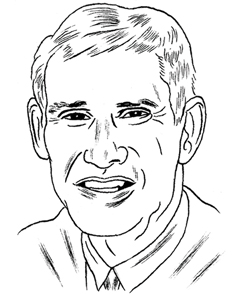Watch This
Wearable devices were supposed to make us smarter and healthier. They were supposed to provide useful data that was previously difficult or even impossible to attain. But activity trackers—the vanguard of the wearables era—have by and large been a failure (see “The Struggle for Accurate Measurements on Your Wrist”). Yes, they’ve counted steps and been used by tens of millions of people, but they haven’t been durable and they haven’t measurably improved our fitness levels.

Yet there’s optimism that by 2020 there will be a trillion digitally connected sensors worldwide. Why?
We’re moving away from lifestyle apps and moving instead toward medical apps that can monitor almost any common chronic illness. A low-cost fingertip sensor can not only obtain your electrocardiogram but also provide an instant, accurate interpretation. The FDA has approved this simple consumer device, which has the potential to be useful for the 20 million Americans who have heart rhythm disorders or are being evaluated for a possible arrhythmia. We also have skin-adhesive patches that capture heart rhythm, oxygen concentration in the blood, and respiratory rate. We have watches that obtain continuous blood pressure readings and sensors that continuously measure glucose. Clusters of sensors are being developed to track asthma, depression, heart failure, movement disorders, sleep apnea, and many other conditions.
Many people are skeptical that the Apple Watch will be useful for medical purposes, but even in its recently released first version, I’ve found it be to remarkably useful for what I call “glucose glances,” with haptic notifications for high or low sugar levels (via an app that also requires a small sensor to be embedded under the skin). A medication app for the watch is very handy for providing reminders and tracking adherence.
But wearables are destined to be transformative beyond matters of convenience. They provide real-world, real-time streaming of medical data. Until now, we’ve practiced one-off medicine. We’ve had no insight about an individual’s blood pressure during stressful moments or sleep, for example. Wearables can give us that, as well as the potential to improve how we analyze data being generated from many sources and sensors. Eventually, we’ll see a “Dr. Siri” virtual medical coach with data analysis capabilities that surpass those of most human beings.
Wearables still face some challenges. They’ll need to be validated in clinical trials. They’ll need to be inexpensive so people will buy them in the first place. We’ll have to find ways to harvest data from large cohorts of patients with particular medical conditions without compromising privacy and security.
And we’ll have to get better at interpreting the data. We can generate terabytes of streaming vital-sign data, but for now we’re long on hoarding and short on analytics.
Some fear only the wealthy will benefit from wearable medicine. I actually think it might make sense to give poor people smartphones, sensors, and data plans—it would still be a lot cheaper than emergency room visits or hospitalizations.
This is a strategy that can work all over the world. Wherever there’s a mobile signal, there’s an opportunity for better health care.
Eric Topol is a professor of genomics at the Scripps Research Institute and the author of The Patient Will See You Now.
Keep Reading
Most Popular
Large language models can do jaw-dropping things. But nobody knows exactly why.
And that's a problem. Figuring it out is one of the biggest scientific puzzles of our time and a crucial step towards controlling more powerful future models.
The problem with plug-in hybrids? Their drivers.
Plug-in hybrids are often sold as a transition to EVs, but new data from Europe shows we’re still underestimating the emissions they produce.
Google DeepMind’s new generative model makes Super Mario–like games from scratch
Genie learns how to control games by watching hours and hours of video. It could help train next-gen robots too.
How scientists traced a mysterious covid case back to six toilets
When wastewater surveillance turns into a hunt for a single infected individual, the ethics get tricky.
Stay connected
Get the latest updates from
MIT Technology Review
Discover special offers, top stories, upcoming events, and more.